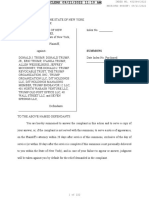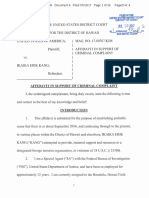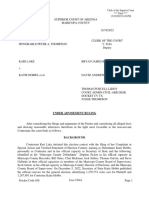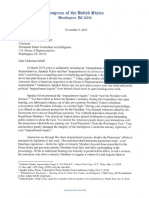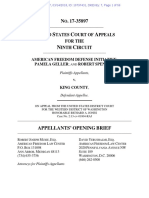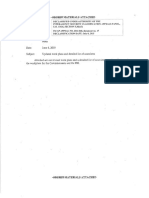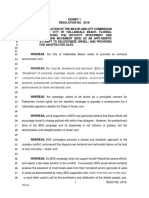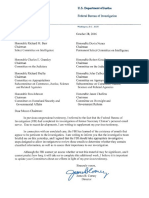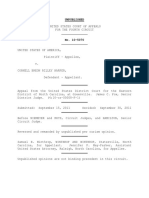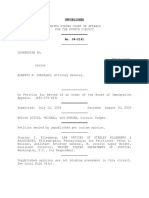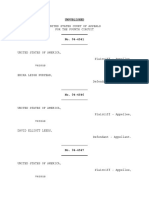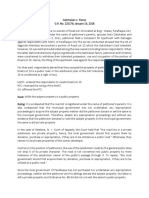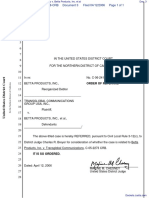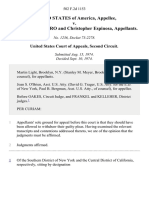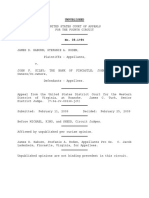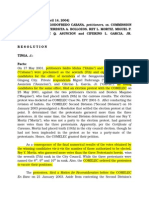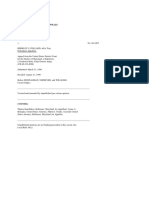Professional Documents
Culture Documents
SCOTUS Thomas Dissent: AFDI vs. MTA
Uploaded by
Pamela Geller0 ratings0% found this document useful (0 votes)
5K views9 pagesThe SCOTUS denied our cert petition in this case. However, Justice Thomas, joined by Justice Alito, filed an excellent dissent, which is attached.
Copyright
© © All Rights Reserved
Available Formats
PDF or read online from Scribd
Share this document
Did you find this document useful?
Is this content inappropriate?
Report this DocumentThe SCOTUS denied our cert petition in this case. However, Justice Thomas, joined by Justice Alito, filed an excellent dissent, which is attached.
Copyright:
© All Rights Reserved
Available Formats
Download as PDF or read online from Scribd
0 ratings0% found this document useful (0 votes)
5K views9 pagesSCOTUS Thomas Dissent: AFDI vs. MTA
Uploaded by
Pamela GellerThe SCOTUS denied our cert petition in this case. However, Justice Thomas, joined by Justice Alito, filed an excellent dissent, which is attached.
Copyright:
© All Rights Reserved
Available Formats
Download as PDF or read online from Scribd
You are on page 1of 9
Cite as: 577 U. 8.__ 2016) 1
THoMas, J, dissenting
SUPREME COURT OF THE UNITED STATES
AMERICAN FREEDOM DEFENSE INITIATIVE, Er AL.
v. KING COUNTY, WASHINGTON
ON PETITION FOR WRIT OF CERTIORARI TO THE UNITED
STATES COURT OF APPEALS FOR THE NINTH CIRCUIT
No, 15-584 Decided March 7, 2016
JUSTICE THOMAS, with whom JUSTICE ALITO joins, dis-
senting from the denial of certiorari.
‘The First Amendment prohibits the government from
“abridging the freedom of speech.” But the Court has
struggled with how that guarantee applies when private
speech occurs on government property. We have afforded
private speech different levels of protection depending on
the forum in which it occurs. See Pleasant Grove City v.
Summum, 555 U. 8. 460, 469-470 (2009). In a “traditional
public forum”—namely, public streets or parks—speech
restrictions must be “narrowly tailored to serve a compel-
ling government interest.” Jd., at 469. That same stand-
ard governs speech restrictions within a “designated
public forum,” which exists “if government property that,
has not traditionally been regarded as a public forum is
intentionally opened up for that purpose.” Ibid. But if the
government creates a limited public forum (also called a
nonpublic forum)—namely, “a forum that is limited to use
by certain groups or dedicated solely to the discussion of
certain subjects’—then speech restrictions need only be
“reasonable and viewpoint neutral.” Id., at 470.
Distinguishing between designated and limited public
forums has proved difficult. We have said that whether
the government created a designated public forum de-
pends on its intent—as evidenced by its “policy and prac-
tice” and “the nature of the [government] property and its
compatibility with expressive activity.” Cornelius v.
NAACP Legal Defense & Ed. Fund, Inc., 473 U.S. 788,
2 AMERICAN FREEDOM DEFENSE INITIATIVE v,
KING COUNTY
THOMAS, J, dissenting
802 (1985). But what this guidance means has bedeviled
federal courts.
‘This case involves a type of forum that has prompted
especially stark divisions among federal courts of appeals:
advertising in public transit spaces. A plurality of this
Court has concluded that a public transit authority that
categorically prohibits advertising involving political
speech does not create a designated public forum. Lehman
v. Shaker Heights, 418 U.S. 298, 300-302 (1974). But
many transit authorities have instead opened their adver-
tising spaces to a wide array of political speech, and courts
of appeals are divided on what type of forum this creates.
Transit authorities in Chicago, Detroit, New York City,
and Washington, D. C., are bound by rulings that classify
their ad spaces as designated public forums and, thus,
prohibit content-based restrictions on advertising. Transit
authorities in Boston—and, in this case, Seattle—are
similarly open to political speech, yet can freely restrict
speech based on its content. Whether public transit ad-
vertising spaces are designated or limited public forums
determines what speech millions of Americans will—or
will not—encounter during their commutes
‘This case offers an ideal opportunity to bring clarity to
an important area of First Amendment law. In the deci-
sion below, the U.S. Court of Appeals for the Ninth Cir-
cuit held that Seattle public transit advertising space is a
limited public forum, ‘The court then allowed the transit
authority to exclude ads submitted by the American Free-
dom Defense Initiative (AFDI)—petitioner here—by apply-
ing content-based advertising restrictions. I would have
granted certiorari.
1
King County, Washington, operates a public transit
system that provides transportation to hundreds of thou-
ands of riders in and around Seattle. Like many transit
Cite as; 577 U.S,__ 2016) 3
THOMAS, J, dissenting
authorities, King County's transit system funds itself in
part by selling advertising space on its buses and other
property. And, like many transit authorities, King County
subjects proposed ads to a preapproval process. Its policy
for evaluating ads prohibits political campaign advertis-
ing, but allows other political messages. Political mes-
sages, however, cannot be displayed if the county deems
them “false or misleading,” “demeaning and disparaging,” or a
risk to the orderly operation of the transit system, 2014
WL 345245, *4 (WD Wash., Jan. 30, 2014).
King County has approved many controversial political
ads. Transit bus exteriors have proclaimed “Save Gaza!
Justice for all.” Riders have encountered ads urging
women to visit a pro-life crisis pregnancy center to discuss
abortion alternatives. Ads have championed “Equal
Rights for Palestinians[] The Way to Peace,” and an-
nounced, “The Palestinian Authority Is Calling For A Jew-
Free State(:] Equal Rights for Jews.” King County even
initially accepted an ad that would have emblazoned
“Israeli War Crimes[,] Your Tax Dollars At Work” on
buses—before withdrawing that acceptance based on
threats of violence. See Seattle Mideast Awareness Cam-
paign v. King County, 781 F.3d 489, 494 (CA9 2015)
(SeaMAC).
In 2013, the State Department and the Federal Bureau
of Investigation (FBI) launched a campaign to encourage
anyone in Scattle—an international travel hub—to report
information about wanted terrorists. To that end, the
State Department submitted ads for King County's ap-
proval to run on bus exteriors.
Consistent with a campaign aimed at soliciting infor-
mation about wanted terrorists, one ad displayed the
names and faces of 16 wanted terrorists beneath the
words “Faces of Global Terrorism.” Appendix, infra. The
bottom of this ad announced: “Stop a Terrorist. Save
Lives. Up to $25 Million Reward.” Ibid. ‘The ad included
4 AMERICAN FREEDOM DEFENSE INITIATIVE v,
KING COUNTY
THOMAS, J, dissenting
contact information for the Rewards for Justice Program,
which offers substantial monetary rewards for information
helping to locate wanted terrorists. See ibid. King
County’s Transit Advertising Program Project Manager
interpreted the ad as a conventional “wanted poster” and
approved it. Record in No. 2:13-CV-01804 (WD Wash.)
(Record), Doe. 14, pp. 4-5 (Shinbo decl.). The ad started
appearing on buses in June 2013. Ibid.
King County then received a “small” number of com-
plaints. Id., at 6. Faultfinders complained that juxtapos-
ing the words “Faces of Global Terrorism” next to “pi
of persons of color with Muslim-sounding names ... sug-
gested that all similar persons were dangerous terrorists,”
and that “just to depict men of certain races is. . . incendi-
ary itself.” Ibid. (internal quotation marks omitted). A
Seattle-area U.S. Congressman echoed these objei
‘The State Department voluntarily withdrew the ad.
Weeks later, petitioner AFDI—an advocacy group that
seeks to convey its views on terrorism by buying public
transit ad space—submitted a proposed ad. See Appendix,
infra. Like the State Department ad, AFDI's ad was
captioned “aces of Global Terrorism.” Ibid. And like the
State Department ad, AFDI's ad displayed the same 16
photos of wanted terrorists, with their names beneath. At
the bottom of the ad, AFDI included slightly different text.
Whereas the State Department ad concluded “Stop a
Terrorist. Save Lives. Up to $25 Million Reward,” AFDI's
ad concluded: “AFDI Wants You to Stop a Terrorist. The
FBI Is Offering Up To $25 Million Reward If You Help
Capture One Of These Jihadis.” Ibid.
King County rejected AFDI's ad as inconsistent with its
policy. First, King County deemed the ad “false or mis-
leading,” because the Government was not offering a $25
million reward for any depicted terrorist, and because the
State Department, not the FBI, offers the rewards. Ree-
ord, Doc. 13, pp. 7-8 (Desmond decl). Second, King
Cite as; 577 U.S,__ 2016) 5
THOMAS, J, dissenting
County considered the ad “demeaning and disparaging” to
minorities “by equating their dress and skin color with
terrorists” and by misusing the term “jihadi.” Id., at 8.
Third, King County believed that the ad could “interfere
with operation of the Metro transit system” because the ad
could alienate riders and discomfort staff. Id., at 9.
AFDI sued, but the Distriet Court rejected AFDI's First
Amendment challenge. It reasoned that the transit sys-
tom's advertising space was a limited public forum, and
that King County's restrictions were reasonable and view-
point neutral. 2014 WL 345245, at *4-*7. ‘The Ninth
Cireuit affirmed. It agreed that King County's transit ad
space was a limited public forum, and considered the
rejection of AFDI's ad as “false or misleading” to be rea-
sonable and viewpoint neutral. 796 F. 3d 1165, 1168-1172
(2015). Tt did not reach King County's other rationales.
Ibid.
I
In the large portions of this country encompassed by the
Second, Sixth, Seventh, and D.C. Circuits, AFDI's ad
would likely have met a different fate. In those Circuits,
accepting a wide array of political and issue-related ads
demonstrates that the government intended to create a
designated (rather than limited) public forum because
“political advertisements .... [are] the hallmark of a publie
forum.” AFDI v. Suburban Mobility Auth. for Regional
Transp., 698 F. 3d 885, 890 (CA6 2012).* In those Cir-
*Accord, New York Magazine v. Metropolitan Transp. Auth., 136
F.8d 123, 130 (CA2 1998) ([TThe advertising space on the outside of
[transit] buses is a designated public forum, because the [authority]
accepts both political and commercial advertising”); Lebron v. Washing-
fon Metropolitan Area Transit Auth., 748 F.2d 883, 896, and n. 6
(CADC 1984) ([T]he Authority here, by accepting political advertising,
has made its subway stations into public fora’); Air Line Pilots Assn,
Int v. Department of Aviation of Chicago, 45 F. 3d 1144, 11521154,
and n, 7 (CAT 1995) (focusing on “whether or to what extent ‘political
6 AMERICAN FREEDOM DEFENSE INITIATIVE v,
KING COUNTY
THOMAS, J, dissenting
cuits, transit authorities that open their ad spaces to
political messages must provide compelling justifications
for restricting ads, and must narrowly tailor any re-
strictions to those justifications.
In the First and Ninth Circuits, however, transit au-
thorities have far more leeway to restrict speech. There,
“a transit agency's decision to allow the display of contro-
versial advertising does not in and of itself establish a
designated public forum.” AFDI v. Massachusetts Bay
Transp. Auth., 781 F.3d 571, 580 (CA1 2015); see Sea-
MAC, 781 F. 34, at 498-499 (similar); see also 796 F. 3d,
at 1168 (decision below, relying on SeaMAC). As the
Ninth Circuit acknowledged, this approach conflicts with
the approaches of “other courts [that] have held that simi-
lar transit advertising programs constitute designated
public forums.” SeaMAC, supra, at 498-499. Materially
similar public transit advertising programs should not
face such different First Amendment constraints based on
geographical happenstance.
This case would allow us to resolve that division. King
County's advertising restrictions cannot pass muster if the
transit advertising space is a designated public forum.
King County bans ads that it deems “false or misleading,”
but this Court considers broad, content-based restrictions
on false statements in political messages to be generally
impermissible. See United States v. Alvarez, 567 U.S.
_ (2012) (plurality opinion) (slip op., at 5~6); see
id, at __—__ (BREYER, J., concurring in judgment) (slip
op., at 8-10), King County's prohibitions on “demeaning
and disparaging” ads, or ads that could disrupt the transit,
system by alienating riders, are also problematic content-
based restrictions. King County may wish to protect
advertisements have been permitted in the past"); Planned Parenthood
Assn./Chicago Area v. Chicago Transit Auth., 767 F.2d 1225, 1282
(CAT 1985) (similar).
Cite as; 577 U.S,__ 2016) 7
THOMAS, J, dissenting
captive riders’ sensibilities, but “we are often “captiv
outside the sanctuary of the home and subject to objec-
tionable speech.” Cohen v. California, 403 U.S. 15, 21
(1971). The government cannot automatically “shut off
discourse solely to protect others from hearing it.” Ibid.
To be sure, this case involves speech that some may
consider offensive, on a politically charged subject. That is,
all the more reason to grant review. “[A] principal fune-
tion of free speech . .. is to invite dispute. It may indeed
best serve its high purpose when it induces a condition of
unrest, creates dissatisfaction with conditions as they are,
or even stirs people to anger.” Texas v. Johnson, 491 U.S.
397, 408-409 (1989) (internal quotation marks omitted).
‘Many of the Court's landmark First Amendment deci-
sions have involved contentious speech in times of na-
tional turmoil. When some States branded the civil rights
movement a threat to public order, the Court decided
whether protesters against segregation could be punished
for purportedly disrupting the peace. E.g., Cox v. Louisi-
ana, 379 U. S. 536, 537-538 (1965). When the Nation was
divided over the Vietnam War, the Court decided whether
the First Amendment prohibits the Government. from
prosecuting a man for wearing a “““F— the Draft””” jacket,
in a courthouse, Cohen, supra, at 16, and whether a public
school could punish students who wear black armbands as
symbols of antiwar protest, Tinker v. Des Moines Inde-
pendent Community School Dist., 393 U.S. 503, 504
(1969). More recently, we have decided whether protest-
ers can brandish signs proclaiming “God Hates Fags”
and “God Hates the USA/Thank God for 9/11”” outside a
soldier's funeral, Snyder v. Phelps, 562 U.S. 443, 447-448
(2011); whether the First Amendment protects videos that.
depict women crushing small animals to death to satisfy
viewers’ sexual fetishes, United States v. Stevens, 559
U.S. 460, 464-466 (2010); and whether States can reject
Confederate-flag license plates, Walker v. Texas Div., Sons
8 AMERICAN FREEDOM DEFENSE INITIATIVE v,
KING COUNTY
THOMAS, J, dissenting
of Confederate Veterans, Inc., 576 U.S. __, __ (2015)
(slip op., at 1).
T see no sound reason to shy away from this First
Amendment ease. It raises an important constitutional
question on which there is an acknowledged and well-
developed division among the Courts of Appeals. One of
this Court's most basic functions is to resolve this kind
of question. I respectfully dissent from the denial of
certiorari.
Cite as: 57 U.S.__ 2016) 9
Appendix to THOMAS, J, dissenting
APPENDIX
Peet
aiwmle@O Skaelid eh10 ha o]e|
‘The top image is the State Department's “Faces of Global Terrorism”
advertisement, which King County approved and allowed to run on its
buses. The bottom image is AFDI's “Faces of Global Terrorism” adver.
tisement, which King County rejected.
You might also like
- Trump Complaint NY AGDocument222 pagesTrump Complaint NY AGIgor DeryshNo ratings yet
- Ikaika Erik Kang AffidavitDocument26 pagesIkaika Erik Kang AffidavitJake Hyman100% (2)
- Thompson MTD Ruling: Judge Peter Thompson Dismissed Defendants' Motions To Dismiss Kari Lake's Historic Eection LawsuitDocument13 pagesThompson MTD Ruling: Judge Peter Thompson Dismissed Defendants' Motions To Dismiss Kari Lake's Historic Eection LawsuitPamela GellerNo ratings yet
- Kari Lake Lawsuit Against Maricopa County Over 2022 ElectionDocument70 pagesKari Lake Lawsuit Against Maricopa County Over 2022 ElectionKyle Becker100% (1)
- Virginia Muslim Haris Qamar Charged With Marking Targets in DC For Islamic StateDocument17 pagesVirginia Muslim Haris Qamar Charged With Marking Targets in DC For Islamic StatePamela GellerNo ratings yet
- ER Volume I - Opening Brief For Review. Submitted by Appellants American Freedom Defense InitiativeDocument14 pagesER Volume I - Opening Brief For Review. Submitted by Appellants American Freedom Defense InitiativePamela GellerNo ratings yet
- American Freedom Defense Initiative, Et Al. v. Washington Metropolitan Area Transit Authority (WMATA) Inbox XDocument16 pagesAmerican Freedom Defense Initiative, Et Al. v. Washington Metropolitan Area Transit Authority (WMATA) Inbox XPamela GellerNo ratings yet
- Republican Witness List - Impeachment ProbeDocument5 pagesRepublican Witness List - Impeachment ProbeThe Conservative Treehouse100% (3)
- Opening Brief Filed: Opening Brief For Review. Submitted by Appellants American Freedom Defense InitiativeDocument56 pagesOpening Brief Filed: Opening Brief For Review. Submitted by Appellants American Freedom Defense InitiativePamela GellerNo ratings yet
- AFDI V WMATA: Petition For Writ of Certiorari in The USDocument114 pagesAFDI V WMATA: Petition For Writ of Certiorari in The USPamela GellerNo ratings yet
- Memos On Saudi Support of The 9/11 AttacksDocument47 pagesMemos On Saudi Support of The 9/11 AttacksPamela GellerNo ratings yet
- Hallandale Anti BDS (BoycottJews) ResolutionDocument3 pagesHallandale Anti BDS (BoycottJews) ResolutionPamela Geller0% (1)
- ER Volume II Filed: American Freedom Defense Initi, Et Al v. King CountyDocument206 pagesER Volume II Filed: American Freedom Defense Initi, Et Al v. King CountyPamela GellerNo ratings yet
- American Freedom Defense Init, Et Al v. WMATA, Et Al "Appellant/Petitioner Reply Brief Filed" (1:15-cv-01038-GKDocument35 pagesAmerican Freedom Defense Init, Et Al v. WMATA, Et Al "Appellant/Petitioner Reply Brief Filed" (1:15-cv-01038-GKPamela GellerNo ratings yet
- American Freedom Defense Init, Et Al v. WMATA, Et Al "Appellant/Petitioner Brief FiledDocument70 pagesAmerican Freedom Defense Init, Et Al v. WMATA, Et Al "Appellant/Petitioner Brief FiledPamela GellerNo ratings yet
- AFDI vs. WMATADocument10 pagesAFDI vs. WMATAPamela GellerNo ratings yet
- Clinton's Email Exchange: Spark Intifada Against IsraelDocument3 pagesClinton's Email Exchange: Spark Intifada Against IsraelPamela GellerNo ratings yet
- AFDI vs. WMATADocument10 pagesAFDI vs. WMATAPamela GellerNo ratings yet
- Court Opinion: AFDI Vs MTA, Free Speech WinDocument28 pagesCourt Opinion: AFDI Vs MTA, Free Speech WinPamela GellerNo ratings yet
- Letter From ComeyDocument3 pagesLetter From ComeyKatie PavlichNo ratings yet
- In Re Tam Fed Circuit en Banc OpinionDocument110 pagesIn Re Tam Fed Circuit en Banc OpinionJennifer ElginNo ratings yet
- Activity in Case 2:14-cv-05335-MSG AMERICAN FREEDOM DEFENSE INITIATIVE Et Al v. SOUTHEASTERN PENNSYLVANIA TRANSPORTATION AUTHORITYDocument33 pagesActivity in Case 2:14-cv-05335-MSG AMERICAN FREEDOM DEFENSE INITIATIVE Et Al v. SOUTHEASTERN PENNSYLVANIA TRANSPORTATION AUTHORITYPamela GellerNo ratings yet
- PCS Statement PDFDocument1 pagePCS Statement PDFPamela GellerNo ratings yet
- Islamization of The Public School Curriculum: Workbook+SectionDocument5 pagesIslamization of The Public School Curriculum: Workbook+SectionPamela GellerNo ratings yet
- SIOA Petition For A Writ of Certiorari in The United States Supreme Court On Behalf of Pamela Geller and Robert SpencerDocument36 pagesSIOA Petition For A Writ of Certiorari in The United States Supreme Court On Behalf of Pamela Geller and Robert SpencerPamela GellerNo ratings yet
- SIOA Petition For A Writ of Certiorari in The United States Supreme Court On Behalf of Pamela Geller and Robert SpencerDocument36 pagesSIOA Petition For A Writ of Certiorari in The United States Supreme Court On Behalf of Pamela Geller and Robert SpencerPamela GellerNo ratings yet
- British Ban: SSHD Disclosure Documents 27.11.13 Part 2Document65 pagesBritish Ban: SSHD Disclosure Documents 27.11.13 Part 2Pamela GellerNo ratings yet
- Complaint W.exhibits ECF FiledDocument45 pagesComplaint W.exhibits ECF FiledPamela GellerNo ratings yet
- Shoe Dog: A Memoir by the Creator of NikeFrom EverandShoe Dog: A Memoir by the Creator of NikeRating: 4.5 out of 5 stars4.5/5 (537)
- Grit: The Power of Passion and PerseveranceFrom EverandGrit: The Power of Passion and PerseveranceRating: 4 out of 5 stars4/5 (587)
- Hidden Figures: The American Dream and the Untold Story of the Black Women Mathematicians Who Helped Win the Space RaceFrom EverandHidden Figures: The American Dream and the Untold Story of the Black Women Mathematicians Who Helped Win the Space RaceRating: 4 out of 5 stars4/5 (894)
- The Yellow House: A Memoir (2019 National Book Award Winner)From EverandThe Yellow House: A Memoir (2019 National Book Award Winner)Rating: 4 out of 5 stars4/5 (98)
- The Little Book of Hygge: Danish Secrets to Happy LivingFrom EverandThe Little Book of Hygge: Danish Secrets to Happy LivingRating: 3.5 out of 5 stars3.5/5 (399)
- On Fire: The (Burning) Case for a Green New DealFrom EverandOn Fire: The (Burning) Case for a Green New DealRating: 4 out of 5 stars4/5 (73)
- The Subtle Art of Not Giving a F*ck: A Counterintuitive Approach to Living a Good LifeFrom EverandThe Subtle Art of Not Giving a F*ck: A Counterintuitive Approach to Living a Good LifeRating: 4 out of 5 stars4/5 (5794)
- Never Split the Difference: Negotiating As If Your Life Depended On ItFrom EverandNever Split the Difference: Negotiating As If Your Life Depended On ItRating: 4.5 out of 5 stars4.5/5 (838)
- Elon Musk: Tesla, SpaceX, and the Quest for a Fantastic FutureFrom EverandElon Musk: Tesla, SpaceX, and the Quest for a Fantastic FutureRating: 4.5 out of 5 stars4.5/5 (474)
- A Heartbreaking Work Of Staggering Genius: A Memoir Based on a True StoryFrom EverandA Heartbreaking Work Of Staggering Genius: A Memoir Based on a True StoryRating: 3.5 out of 5 stars3.5/5 (231)
- The Emperor of All Maladies: A Biography of CancerFrom EverandThe Emperor of All Maladies: A Biography of CancerRating: 4.5 out of 5 stars4.5/5 (271)
- The Gifts of Imperfection: Let Go of Who You Think You're Supposed to Be and Embrace Who You AreFrom EverandThe Gifts of Imperfection: Let Go of Who You Think You're Supposed to Be and Embrace Who You AreRating: 4 out of 5 stars4/5 (1090)
- The World Is Flat 3.0: A Brief History of the Twenty-first CenturyFrom EverandThe World Is Flat 3.0: A Brief History of the Twenty-first CenturyRating: 3.5 out of 5 stars3.5/5 (2219)
- Team of Rivals: The Political Genius of Abraham LincolnFrom EverandTeam of Rivals: The Political Genius of Abraham LincolnRating: 4.5 out of 5 stars4.5/5 (234)
- The Hard Thing About Hard Things: Building a Business When There Are No Easy AnswersFrom EverandThe Hard Thing About Hard Things: Building a Business When There Are No Easy AnswersRating: 4.5 out of 5 stars4.5/5 (344)
- Devil in the Grove: Thurgood Marshall, the Groveland Boys, and the Dawn of a New AmericaFrom EverandDevil in the Grove: Thurgood Marshall, the Groveland Boys, and the Dawn of a New AmericaRating: 4.5 out of 5 stars4.5/5 (265)
- The Unwinding: An Inner History of the New AmericaFrom EverandThe Unwinding: An Inner History of the New AmericaRating: 4 out of 5 stars4/5 (45)
- The Sympathizer: A Novel (Pulitzer Prize for Fiction)From EverandThe Sympathizer: A Novel (Pulitzer Prize for Fiction)Rating: 4.5 out of 5 stars4.5/5 (119)
- Her Body and Other Parties: StoriesFrom EverandHer Body and Other Parties: StoriesRating: 4 out of 5 stars4/5 (821)
- United States Court of Appeals, Fourth CircuitDocument2 pagesUnited States Court of Appeals, Fourth CircuitScribd Government DocsNo ratings yet
- Abad Santos V Province of TarlacDocument3 pagesAbad Santos V Province of TarlacRan NgiNo ratings yet
- 204 Administrative LawDocument125 pages204 Administrative Lawbhatt.net.inNo ratings yet
- Horrigan v. TroikaDocument1 pageHorrigan v. Troikakim_santos_20No ratings yet
- United States v. Cornell Harper, 4th Cir. (2011)Document3 pagesUnited States v. Cornell Harper, 4th Cir. (2011)Scribd Government DocsNo ratings yet
- Philippine labor dispute appeal dismissal motionDocument2 pagesPhilippine labor dispute appeal dismissal motionSanchez Roman VictorNo ratings yet
- Sands v. Runyon, 52 F.3d 311, 2d Cir. (1995)Document1 pageSands v. Runyon, 52 F.3d 311, 2d Cir. (1995)Scribd Government DocsNo ratings yet
- Students For Fair Admissions v. University of North CarolinaDocument10 pagesStudents For Fair Admissions v. University of North CarolinaCato InstituteNo ratings yet
- United States v. Carl Akins, 4th Cir. (2013)Document4 pagesUnited States v. Carl Akins, 4th Cir. (2013)Scribd Government DocsNo ratings yet
- Computer Associates International v. AltaiDocument2 pagesComputer Associates International v. Altaiaspiringlawyer1234No ratings yet
- Ho v. Gonzales, 4th Cir. (2005)Document3 pagesHo v. Gonzales, 4th Cir. (2005)Scribd Government DocsNo ratings yet
- United States v. Puryear, 4th Cir. (2006)Document5 pagesUnited States v. Puryear, 4th Cir. (2006)Scribd Government DocsNo ratings yet
- Garratt v. Dailey BriefDocument1 pageGarratt v. Dailey Briefzooq5No ratings yet
- Gatchalian Vs FloresDocument1 pageGatchalian Vs FloresKatNo ratings yet
- Transglobal Communciation Group, USA, Inc v. Betta Products, Inc. Et Al - Document No. 3Document1 pageTransglobal Communciation Group, USA, Inc v. Betta Products, Inc. Et Al - Document No. 3Justia.comNo ratings yet
- United States v. Jamar Hunter, 4th Cir. (2016)Document3 pagesUnited States v. Jamar Hunter, 4th Cir. (2016)Scribd Government DocsNo ratings yet
- Frank V KosuyamaDocument2 pagesFrank V KosuyamaPablo Jan Marc FilioNo ratings yet
- United States v. Samuel F. Manarite, 434 F.2d 1069, 2d Cir. (1970)Document2 pagesUnited States v. Samuel F. Manarite, 434 F.2d 1069, 2d Cir. (1970)Scribd Government DocsNo ratings yet
- Ambil V ComelecDocument1 pageAmbil V ComelecGayeGabriel100% (1)
- Brunei Legal System - Chapter 2Document4 pagesBrunei Legal System - Chapter 2isabella1113100% (1)
- United States v. William Rovendro and Christopher Espinosa, 502 F.2d 1153, 2d Cir. (1974)Document1 pageUnited States v. William Rovendro and Christopher Espinosa, 502 F.2d 1153, 2d Cir. (1974)Scribd Government DocsNo ratings yet
- United States Court of Appeals, Fourth CircuitDocument2 pagesUnited States Court of Appeals, Fourth CircuitScribd Government DocsNo ratings yet
- Colon v. Apex Marine, 1st Cir. (1994)Document6 pagesColon v. Apex Marine, 1st Cir. (1994)Scribd Government DocsNo ratings yet
- Catholic Vicar v. CA DigestDocument2 pagesCatholic Vicar v. CA DigestPaul PhoenixNo ratings yet
- Cesar Sampayan vs. Crispulo Vasquez and Florencia Vasquez-Galisano (GR No. 156360, 14 Jan 2005)Document3 pagesCesar Sampayan vs. Crispulo Vasquez and Florencia Vasquez-Galisano (GR No. 156360, 14 Jan 2005)Archibald Jose Tiago ManansalaNo ratings yet
- Haburn v. Kilby, 4th Cir. (2009)Document2 pagesHaburn v. Kilby, 4th Cir. (2009)Scribd Government DocsNo ratings yet
- United States v. Maurice Parks, 4th Cir. (2015)Document3 pagesUnited States v. Maurice Parks, 4th Cir. (2015)Scribd Government DocsNo ratings yet
- COMELEC Ruling on Gingoog City Election Protest UpheldDocument4 pagesCOMELEC Ruling on Gingoog City Election Protest UpheldBonD.J.DomingoNo ratings yet
- United States v. Berkley Pollard, 4th Cir. (1999)Document3 pagesUnited States v. Berkley Pollard, 4th Cir. (1999)Scribd Government DocsNo ratings yet
- Court DecisonDocument2 pagesCourt DecisonThe Western JournalNo ratings yet
